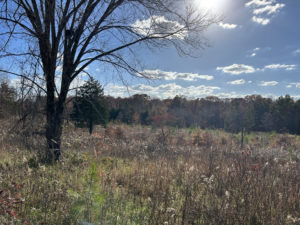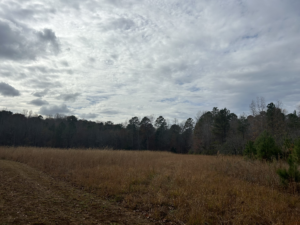By Blakely Durham, Education and Outreach Intern Fall 2023
It’s hard to imagine now, but prairies used to dominate the Piedmont. These areas were characterized by disturbance from grazing bison and frequent fires. Fires were initially the result of lightning but were then incorporated into the land management practices of Indigenous peoples.
Fire helps reset the ecosystem. It returns nutrients to the soil and clears away debris. It also prevents trees from getting too established, allowing only the species that can quickly and continually reestablish themselves, like red oaks, to prevail. I consider oaks supertrees. They support more life forms than any other North American tree species and their heavy leaf litter provides an important habitat for decomposers. Oaks are only one part of the amazingly diverse prairie habitat. Pollinator plants, like milkweed and mountain mint, also thrive. Bunch grasses provide safe spaces for birds to nest.
But with European settlement, more and more prairies were converted into farmland. After farms came development, further erasing prairies from the Southeast’s memory. Even where there was no development, the lack of fire (due to the removal of Indigenous people and their knowledge) allowed trees to establish themselves and form the forests we are familiar with today. Only small fragments remain. The shoulders of roads and the area beneath power lines provide glimpses of what could have been.
Using historical maps and photos, TLC is working to restore these prairies. The stewardship team, with the help of volunteers, removes both invasive and unwanted tree species, including tree of heaven (invasive) and sweet gum (unwanted). The limbs of these trees are then used to create brush piles, which provide habitat for animals. These species are also cleared through the use of prescribed burns.
In areas near old growth forests, like what you’ll find at Brumley’s north section and Horton Grove, stewardship efforts are focused on maintaining a healthy edge, with help from a Cornell Lab of Ornithology grant. A gradual transition between the two habitats allows for great diversity in plants and animals. The wider and more vertically complex, the better! This entails thinning of overstory trees, so understory species can thrive. Stewardship helps move this process along by planting desirable native species such as spicebush and pawpaw.
So, the next time you pass by a wild grassy area, remember that they used to span as far as the eye can see. If you want to immerse yourself in their beauty, consider a visit to one of TLC’s preserves!


